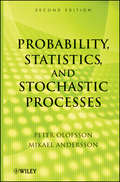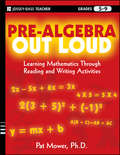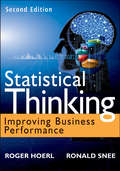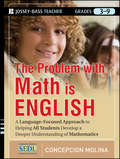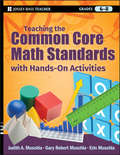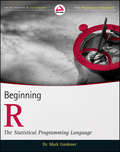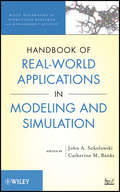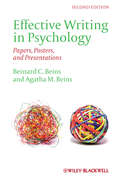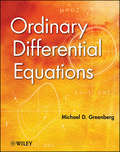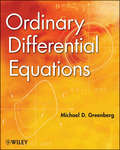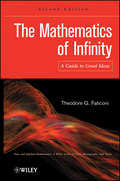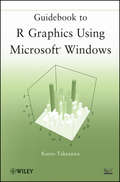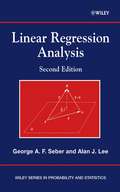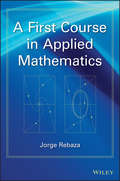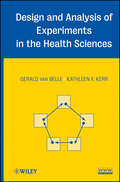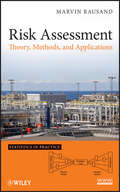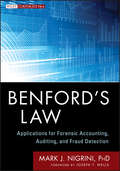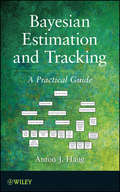- Table View
- List View
Probability, Statistics, and Stochastic Processes
by Peter Olofsson Mikael AnderssonPraise for the First Edition ". . . an excellent textbook . . . well organized and neatly written." —Mathematical Reviews ". . . amazingly interesting . . ." —Technometrics Thoroughly updated to showcase the interrelationships between probability, statistics, and stochastic processes, Probability, Statistics, and Stochastic Processes, Second Edition prepares readers to collect, analyze, and characterize data in their chosen fields. Beginning with three chapters that develop probability theory and introduce the axioms of probability, random variables, and joint distributions, the book goes on to present limit theorems and simulation. The authors combine a rigorous, calculus-based development of theory with an intuitive approach that appeals to readers' sense of reason and logic. Including more than 400 examples that help illustrate concepts and theory, the Second Edition features new material on statistical inference and a wealth of newly added topics, including: Consistency of point estimators Large sample theory Bootstrap simulation Multiple hypothesis testing Fisher's exact test and Kolmogorov-Smirnov test Martingales, renewal processes, and Brownian motion One-way analysis of variance and the general linear model Extensively class-tested to ensure an accessible presentation, Probability, Statistics, and Stochastic Processes, Second Edition is an excellent book for courses on probability and statistics at the upper-undergraduate level. The book is also an ideal resource for scientists and engineers in the fields of statistics, mathematics, industrial management, and engineering.
Probability, Statistics, and Stochastic Processes
by Peter Olofsson Mikael AnderssonPraise for the First Edition ". . . an excellent textbook . . . well organized and neatly written." —Mathematical Reviews ". . . amazingly interesting . . ." —Technometrics Thoroughly updated to showcase the interrelationships between probability, statistics, and stochastic processes, Probability, Statistics, and Stochastic Processes, Second Edition prepares readers to collect, analyze, and characterize data in their chosen fields. Beginning with three chapters that develop probability theory and introduce the axioms of probability, random variables, and joint distributions, the book goes on to present limit theorems and simulation. The authors combine a rigorous, calculus-based development of theory with an intuitive approach that appeals to readers' sense of reason and logic. Including more than 400 examples that help illustrate concepts and theory, the Second Edition features new material on statistical inference and a wealth of newly added topics, including: Consistency of point estimators Large sample theory Bootstrap simulation Multiple hypothesis testing Fisher's exact test and Kolmogorov-Smirnov test Martingales, renewal processes, and Brownian motion One-way analysis of variance and the general linear model Extensively class-tested to ensure an accessible presentation, Probability, Statistics, and Stochastic Processes, Second Edition is an excellent book for courses on probability and statistics at the upper-undergraduate level. The book is also an ideal resource for scientists and engineers in the fields of statistics, mathematics, industrial management, and engineering.
Pre-Algebra Out Loud: Learning Mathematics Through Reading and Writing Activities
by Pat MowerAn essential guide for teaching students in grades 5-9 how to write about math Learning to read and write efficiently regarding mathematics helps students to understand content at a deeper level. In this third book in the popular math 'Out Loud' series, Mower provides a variety of reading and writing strategies and activities suitable for elementary and middle school pre-algebra courses, covering such key skills as integers and exponents, fractions, decimals and percents, graphing, statistics, factoring, evaluating expressions, geometry and the basics of equations. Includes dozens of classroom tested strategies and techniques Shows how reading and writing can be incorporated in any math class to improve math skills Provides unique, fun activities that will keep students interested and make learning stick This important guide offers teachers easy-to-apply lessons that will help students develop a deeper understanding of mathematics.
Statistical Thinking: Improving Business Performance (Wiley and SAS Business Series #58)
by Roger Hoerl Ron D. SneeHow statistical thinking and methodology can help you make crucial business decisions Straightforward and insightful, Statistical Thinking: Improving Business Performance, Second Edition, prepares you for business leadership by developing your capacity to apply statistical thinking to improve business processes. Unique and compelling, this book shows you how to derive actionable conclusions from data analysis, solve real problems, and improve real processes. Here, you'll discover how to implement statistical thinking and methodology in your work to improve business performance. Explores why statistical thinking is necessary and helpful Provides case studies that illustrate how to integrate several statistical tools into the decision-making process Facilitates and encourages an experiential learning environment to enable you to apply material to actual problems With an in-depth discussion of JMP® software, the new edition of this important book focuses on skills to improve business processes, including collecting data appropriate for a specified purpose, recognizing limitations in existing data, and understanding the limitations of statistical analyses.
The Problem with Math Is English: A Language-Focused Approach to Helping All Students Develop a Deeper Understanding of Mathematics
by Concepcion MolinaTeaching K-12 math becomes an easier task when everyone understands the language, symbolism, and representation of math concepts Published in partnership with SEDL, The Problem with Math Is English illustrates how students often understand fundamental mathematical concepts at a superficial level. Written to inspire ?aha? moments, this book enables teachers to help students identify and comprehend the nuances and true meaning of math concepts by exploring them through the lenses of language and symbolism, delving into such essential topics as multiplication, division, fractions, place value, proportional reasoning, graphs, slope, order of operations, and the distributive property. Offers a new way to approach teaching math content in a way that will improve how all students, and especially English language learners, understand math Emphasizes major attributes of conceptual understanding in mathematics, including simple yet deep definitions of key terms, connections among key topics, and insightful interpretation This important new book fills a gap in math education by illustrating how a deeper knowledge of math concepts can be developed in all students through a focus on language and symbolism.
Teaching the Common Core Math Standards with Hands-On Activities, Grades 6-8
by Judith A. Muschla Gary Robert Muschla Erin MuschlaHelpful advice for teaching Common Core Math Standards to middle-school students The new Common Core State Standards for Mathematics have been formulated to provide students with instruction that will help them acquire a thorough knowledge of math at their grade level, which will in turn enable them to move on to higher mathematics with competence and confidence. Hands-on Activities for Teaching the Common Core Math Standards is designed to help teachers instruct their students so that they will better understand and apply the skills outlined in the Standards. This important resource also gives teachers a wealth of tools and activities that can encourage students to think critically, use mathematical reasoning, and employ various problem-solving strategies. Filled with activities that will help students gain an understanding of math concepts and skills correlated to the Common Core State Math Standards Offers guidance for helping students apply their understanding of math concepts and skills, develop proficiency in calculations, and learn to think abstractly Describes ways to get students to collaborate with other students, utilize technology, communicate ideas about math both orally and in writing, and gain an appreciation of the significance of mathematics to real life This practical and easy-to-use resource will help teachers give students the foundation they need for success in higher mathematics.
Beginning R: The Statistical Programming Language
by Mark GardenerConquer the complexities of this open source statistical language R is fast becoming the de facto standard for statistical computing and analysis in science, business, engineering, and related fields. This book examines this complex language using simple statistical examples, showing how R operates in a user-friendly context. Both students and workers in fields that require extensive statistical analysis will find this book helpful as they learn to use R for simple summary statistics, hypothesis testing, creating graphs, regression, and much more. It covers formula notation, complex statistics, manipulating data and extracting components, and rudimentary programming. R, the open source statistical language increasingly used to handle statistics and produces publication-quality graphs, is notoriously complex This book makes R easier to understand through the use of simple statistical examples, teaching the necessary elements in the context in which R is actually used Covers getting started with R and using it for simple summary statistics, hypothesis testing, and graphs Shows how to use R for formula notation, complex statistics, manipulating data, extracting components, and regression Provides beginning programming instruction for those who want to write their own scripts Beginning R offers anyone who needs to perform statistical analysis the information necessary to use R with confidence.
Handbook of Real-World Applications in Modeling and Simulation (Wiley Series in Operations Research and Management Science #2)
by John A. Sokolowski Catherine M. BanksIntroduces various modeling and simulation methods and paradigms that are used to explain and solve the predominant challenges facing society Handbook of Real-World Applications in Modeling and Simulation provides a thorough explanation of modeling and simulation in the most useful, current, and predominant applied areas of transportation, homeland security, medicine, operational research, military science, and business modeling. Offering a cutting-edge and accessible presentation, this book discusses how and why the presented domains have become leading applications of modeling and simulation techniques. Contributions from leading academics and researchers integrate modeling and simulation theories, methods, and data to analyze challenges that involve technological and social issues. The book begins with an introduction that explains why modeling and simulation is a reliable analysis assessment tool for complex systems problems. Subsequent chapters provide an orientation to various modeling and simulation methods and paradigms that are used to explain and solve the predominant challenges across real-world applied domains. Additionally, the handbook: Provides a practical one-stop reference on modeling and simulation and contains an accessible introduction to key concepts and techniques Introduces, trains, and prepares readers from statistics, mathematics, engineering, computer science, economics, and business to use modeling and simulation in their studies and research Features case studies that are representative of fundamental areas of multidisciplinary studies and provides a concise look at the key concepts of modeling and simulation Contains a collection of original ideas on modeling and simulation to help academics and practitioners develop a multifunctional perspective Self-contained chapters offer a comprehensive approach to explaining each respective domain and include sections that explore the related history, theory, modeling paradigms, and case studies. Key terms and techniques are clearly outlined, and exercise sets allow readers to test their comprehension of the presented material. Handbook of Real-World Applications in Modeling and Simulation is an essential reference for academics and practitioners in the areas of operations research, business, management science, engineering, statistics, mathematics, and computer science. The handbook is also a suitable supplement for courses on modeling and simulation at the graduate level.
Handbook of Real-World Applications in Modeling and Simulation (Wiley Series in Operations Research and Management Science #2)
by John A. Sokolowski Catherine M. BanksIntroduces various modeling and simulation methods and paradigms that are used to explain and solve the predominant challenges facing society Handbook of Real-World Applications in Modeling and Simulation provides a thorough explanation of modeling and simulation in the most useful, current, and predominant applied areas of transportation, homeland security, medicine, operational research, military science, and business modeling. Offering a cutting-edge and accessible presentation, this book discusses how and why the presented domains have become leading applications of modeling and simulation techniques. Contributions from leading academics and researchers integrate modeling and simulation theories, methods, and data to analyze challenges that involve technological and social issues. The book begins with an introduction that explains why modeling and simulation is a reliable analysis assessment tool for complex systems problems. Subsequent chapters provide an orientation to various modeling and simulation methods and paradigms that are used to explain and solve the predominant challenges across real-world applied domains. Additionally, the handbook: Provides a practical one-stop reference on modeling and simulation and contains an accessible introduction to key concepts and techniques Introduces, trains, and prepares readers from statistics, mathematics, engineering, computer science, economics, and business to use modeling and simulation in their studies and research Features case studies that are representative of fundamental areas of multidisciplinary studies and provides a concise look at the key concepts of modeling and simulation Contains a collection of original ideas on modeling and simulation to help academics and practitioners develop a multifunctional perspective Self-contained chapters offer a comprehensive approach to explaining each respective domain and include sections that explore the related history, theory, modeling paradigms, and case studies. Key terms and techniques are clearly outlined, and exercise sets allow readers to test their comprehension of the presented material. Handbook of Real-World Applications in Modeling and Simulation is an essential reference for academics and practitioners in the areas of operations research, business, management science, engineering, statistics, mathematics, and computer science. The handbook is also a suitable supplement for courses on modeling and simulation at the graduate level.
Effective Writing in Psychology: Papers, Posters,and Presentations
by Bernard C. Beins Agatha M. BeinsThe second edition of Effective Writing in Psychology helps users produce crisp scientific communication, form concise unambiguous arguments, and render technical information clear and comprehensible. The new edition incorporates the latest guidelines contained within the 6th edition of the APA Publication Manual. Clear guidelines on effective writing illustrate how to generate strong and compelling prose, even when the writing is not aimed at a research audience Incorporates changes to the guidelines contained in the 6th edition of the APA publication manual Includes material on how to adapt APA style for poster presentations using PowerPoint, and for oral presentations Contains a new section on using the Internet to present research papers and a new chapter on conducting a literature search, to guide students through databases, keywords, sources, and connections between articles Highlights methods for selecting a research topic and organizing papers Features a sample manuscript showing common deviations from correct APA style and a version demonstrating appropriate use of APA style
Effective Writing in Psychology: Papers, Posters,and Presentations (Wiley Desktop Editions Ser.)
by Bernard C. Beins Agatha M. BeinsThe second edition of Effective Writing in Psychology helps users produce crisp scientific communication, form concise unambiguous arguments, and render technical information clear and comprehensible. The new edition incorporates the latest guidelines contained within the 6th edition of the APA Publication Manual. Clear guidelines on effective writing illustrate how to generate strong and compelling prose, even when the writing is not aimed at a research audience Incorporates changes to the guidelines contained in the 6th edition of the APA publication manual Includes material on how to adapt APA style for poster presentations using PowerPoint, and for oral presentations Contains a new section on using the Internet to present research papers and a new chapter on conducting a literature search, to guide students through databases, keywords, sources, and connections between articles Highlights methods for selecting a research topic and organizing papers Features a sample manuscript showing common deviations from correct APA style and a version demonstrating appropriate use of APA style
Ordinary Differential Equations
by Michael D. GreenbergFeatures a balance between theory, proofs, and examples and provides applications across diverse fields of study Ordinary Differential Equations presents a thorough discussion of first-order differential equations and progresses to equations of higher order. The book transitions smoothly from first-order to higher-order equations, allowing readers to develop a complete understanding of the related theory. Featuring diverse and interesting applications from engineering, bioengineering, ecology, and biology, the book anticipates potential difficulties in understanding the various solution steps and provides all the necessary details. Topical coverage includes: First-Order Differential Equations Higher-Order Linear Equations Applications of Higher-Order Linear Equations Systems of Linear Differential Equations Laplace Transform Series Solutions Systems of Nonlinear Differential Equations In addition to plentiful exercises and examples throughout, each chapter concludes with a summary that outlines key concepts and techniques. The book's design allows readers to interact with the content, while hints, cautions, and emphasis are uniquely featured in the margins to further help and engage readers. Written in an accessible style that includes all needed details and steps, Ordinary Differential Equations is an excellent book for courses on the topic at the upper-undergraduate level. The book also serves as a valuable resource for professionals in the fields of engineering, physics, and mathematics who utilize differential equations in their everyday work. An Instructors Manual is available upon request. Email sfriedman@wiley.com for information. There is also a Solutions Manual available. The ISBN is 9781118398999.
Ordinary Differential Equations
by Michael D. GreenbergFeatures a balance between theory, proofs, and examples and provides applications across diverse fields of study Ordinary Differential Equations presents a thorough discussion of first-order differential equations and progresses to equations of higher order. The book transitions smoothly from first-order to higher-order equations, allowing readers to develop a complete understanding of the related theory. Featuring diverse and interesting applications from engineering, bioengineering, ecology, and biology, the book anticipates potential difficulties in understanding the various solution steps and provides all the necessary details. Topical coverage includes: First-Order Differential Equations Higher-Order Linear Equations Applications of Higher-Order Linear Equations Systems of Linear Differential Equations Laplace Transform Series Solutions Systems of Nonlinear Differential Equations In addition to plentiful exercises and examples throughout, each chapter concludes with a summary that outlines key concepts and techniques. The book's design allows readers to interact with the content, while hints, cautions, and emphasis are uniquely featured in the margins to further help and engage readers. Written in an accessible style that includes all needed details and steps, Ordinary Differential Equations is an excellent book for courses on the topic at the upper-undergraduate level. The book also serves as a valuable resource for professionals in the fields of engineering, physics, and mathematics who utilize differential equations in their everyday work. An Instructors Manual is available upon request. Email sfriedman@wiley.com for information. There is also a Solutions Manual available. The ISBN is 9781118398999.
The Mathematics of Infinity: A Guide to Great Ideas (Pure and Applied Mathematics: A Wiley Series of Texts, Monographs and Tracts #111)
by Theodore G. FaticoniPraise for the First Edition ". . . an enchanting book for those people in computer science or mathematics who are fascinated by the concept of infinity."—Computing Reviews ". . . a very well written introduction to set theory . . . easy to read and well suited for self-study . . . highly recommended."—Choice The concept of infinity has fascinated and confused mankind for centuries with theories and ideas that cause even seasoned mathematicians to wonder. The Mathematics of Infinity: A Guide to Great Ideas, Second Edition uniquely explores how we can manipulate these ideas when our common sense rebels at the conclusions we are drawing. Continuing to draw from his extensive work on the subject, the author provides a user-friendly presentation that avoids unnecessary, in-depth mathematical rigor. This Second Edition provides important coverage of logic and sets, elements and predicates, cardinals as ordinals, and mathematical physics. Classic arguments and illustrative examples are provided throughout the book and are accompanied by a gradual progression of sophisticated notions designed to stun readers' intuitive view of the world. With an accessible and balanced treatment of both concepts and theory, the book focuses on the following topics: Logic, sets, and functions Prime numbers Counting infinite sets Well ordered sets Infinite cardinals Logic and meta-mathematics Inductions and numbers Presenting an intriguing account of the notions of infinity, The Mathematics of Infinity: A Guide to Great Ideas, Second Edition is an insightful supplement for mathematics courses on set theory at the undergraduate level. The book also serves as a fascinating reference for mathematically inclined individuals who are interested in learning about the world of counterintuitive mathematics.
Guidebook to R Graphics Using Microsoft Windows
by Kunio TakezawaIntroduces the graphical capabilities of R to readers new to the software Due to its flexibility and availability, R has become the computing software of choice for statistical computing and generating graphics across various fields of research. Guidebook to R Graphics Using Microsoft® Windows offers a unique presentation of R, guiding new users through its many benefits, including the creation of high-quality graphics. Beginning with getting the program up and running, this book takes readers step by step through the process of creating histograms, boxplots, strip charts, time series graphs, steam-and-leaf displays, scatterplot matrices, and map graphs. In addition, the book presents: Tips for establishing, saving, and printing graphs along with essential base-package plotting functions Interactive R programs for carrying out common tasks such as inputting values, moving data on a natural spline, adjusting three-dimensional graphs, and understanding simple and local linear regression Various external packages for R that help to create more complex graphics like rimage, gplots, ggplot2, tripack, rworldmap, and plotrix packages Throughout the book, concise explanations of key concepts of R graphics assist readers in carrying out the presented procedures, and any coverage of functions is clearly written out and displayed in the text as demos. The discussed techniques are accompanied by a wealth of screenshots and graphics with related R code available on the book's FTP site, and numerous exercises allow readers to test their understanding of the presented material. Guidebook to R Graphics Using Microsoft® Windows is a valuable resource for researchers in the fields of statistics, public health, business, and the life and social sciences who use or would like to learn how to use R to create visual representations of data. The book can also be used as a supplement for courses on statistical analysis at the upper-undergraduate level.
Guidebook to R Graphics Using Microsoft Windows
by Kunio TakezawaIntroduces the graphical capabilities of R to readers new to the software Due to its flexibility and availability, R has become the computing software of choice for statistical computing and generating graphics across various fields of research. Guidebook to R Graphics Using Microsoft® Windows offers a unique presentation of R, guiding new users through its many benefits, including the creation of high-quality graphics. Beginning with getting the program up and running, this book takes readers step by step through the process of creating histograms, boxplots, strip charts, time series graphs, steam-and-leaf displays, scatterplot matrices, and map graphs. In addition, the book presents: Tips for establishing, saving, and printing graphs along with essential base-package plotting functions Interactive R programs for carrying out common tasks such as inputting values, moving data on a natural spline, adjusting three-dimensional graphs, and understanding simple and local linear regression Various external packages for R that help to create more complex graphics like rimage, gplots, ggplot2, tripack, rworldmap, and plotrix packages Throughout the book, concise explanations of key concepts of R graphics assist readers in carrying out the presented procedures, and any coverage of functions is clearly written out and displayed in the text as demos. The discussed techniques are accompanied by a wealth of screenshots and graphics with related R code available on the book's FTP site, and numerous exercises allow readers to test their understanding of the presented material. Guidebook to R Graphics Using Microsoft® Windows is a valuable resource for researchers in the fields of statistics, public health, business, and the life and social sciences who use or would like to learn how to use R to create visual representations of data. The book can also be used as a supplement for courses on statistical analysis at the upper-undergraduate level.
Linear Regression Analysis (Wiley Series in Probability and Statistics #329)
by George A. Seber Alan J. LeeConcise, mathematically clear, and comprehensive treatment of the subject. * Expanded coverage of diagnostics and methods of model fitting. * Requires no specialized knowledge beyond a good grasp of matrix algebra and some acquaintance with straight-line regression and simple analysis of variance models. * More than 200 problems throughout the book plus outline solutions for the exercises. * This revision has been extensively class-tested.
A First Course in Applied Mathematics
by Jorge RebazaExplore real-world applications of selected mathematical theory, concepts, and methods Exploring related methods that can be utilized in various fields of practice from science and engineering to business, A First Course in Applied Mathematics details how applied mathematics involves predictions, interpretations, analysis, and mathematical modeling to solve real-world problems. Written at a level that is accessible to readers from a wide range of scientific and engineering fields, the book masterfully blends standard topics with modern areas of application and provides the needed foundation for transitioning to more advanced subjects. The author utilizes MATLAB® to showcase the presented theory and illustrate interesting real-world applications to Google's web page ranking algorithm, image compression, cryptography, chaos, and waste management systems. Additional topics covered include: Linear algebra Ranking web pages Matrix factorizations Least squares Image compression Ordinary differential equations Dynamical systems Mathematical models Throughout the book, theoretical and applications-oriented problems and exercises allow readers to test their comprehension of the presented material. An accompanying website features related MATLAB® code and additional resources. A First Course in Applied Mathematics is an ideal book for mathematics, computer science, and engineering courses at the upper-undergraduate level. The book also serves as a valuable reference for practitioners working with mathematical modeling, computational methods, and the applications of mathematics in their everyday work.
Design and Analysis of Experiments in the Health Sciences
by Gerald van Belle Kathleen F. KerrAn accessible and practical approach to the design and analysis of experiments in the health sciences Design and Analysis of Experiments in the Health Sciences provides a balanced presentation of design and analysis issues relating to data in the health sciences and emphasizes new research areas, the crucial topic of clinical trials, and state-of-the- art applications. Advancing the idea that design drives analysis and analysis reveals the design, the book clearly explains how to apply design and analysis principles in animal, human, and laboratory experiments while illustrating topics with applications and examples from randomized clinical trials and the modern topic of microarrays. The authors outline the following five types of designs that form the basis of most experimental structures: Completely randomized designs Randomized block designs Factorial designs Multilevel experiments Repeated measures designs A related website features a wealth of data sets that are used throughout the book, allowing readers to work hands-on with the material. In addition, an extensive bibliography outlines additional resources for further study of the presented topics. Requiring only a basic background in statistics, Design and Analysis of Experiments in the Health Sciences is an excellent book for introductory courses on experimental design and analysis at the graduate level. The book also serves as a valuable resource for researchers in medicine, dentistry, nursing, epidemiology, statistical genetics, and public health.
Design and Analysis of Experiments in the Health Sciences
by Gerald van Belle Kathleen F. KerrAn accessible and practical approach to the design and analysis of experiments in the health sciences Design and Analysis of Experiments in the Health Sciences provides a balanced presentation of design and analysis issues relating to data in the health sciences and emphasizes new research areas, the crucial topic of clinical trials, and state-of-the- art applications. Advancing the idea that design drives analysis and analysis reveals the design, the book clearly explains how to apply design and analysis principles in animal, human, and laboratory experiments while illustrating topics with applications and examples from randomized clinical trials and the modern topic of microarrays. The authors outline the following five types of designs that form the basis of most experimental structures: Completely randomized designs Randomized block designs Factorial designs Multilevel experiments Repeated measures designs A related website features a wealth of data sets that are used throughout the book, allowing readers to work hands-on with the material. In addition, an extensive bibliography outlines additional resources for further study of the presented topics. Requiring only a basic background in statistics, Design and Analysis of Experiments in the Health Sciences is an excellent book for introductory courses on experimental design and analysis at the graduate level. The book also serves as a valuable resource for researchers in medicine, dentistry, nursing, epidemiology, statistical genetics, and public health.
Risk Assessment: Theory, Methods, and Applications (Statistics in Practice #115)
by Marvin RausandAn introduction to risk assessment that utilizes key theory and state-of-the-art applications With its balanced coverage of theory and applications along with standards and regulations, Risk Assessment: Theory, Methods, and Applications serves as a comprehensive introduction to the topic. The book serves as a practical guide to current risk analysis and risk assessment, emphasizing the possibility of sudden, major accidents across various areas of practice from machinery and manufacturing processes to nuclear power plants and transportation systems. The author applies a uniform framework to the discussion of each method, setting forth clear objectives and descriptions, while also shedding light on applications, essential resources, and advantages and disadvantages. Following an introduction that provides an overview of risk assessment, the book is organized into two sections that outline key theory, methods, and applications. Introduction to Risk Assessment defines key concepts and details the steps of a thorough risk assessment along with the necessary quantitative risk measures. Chapters outline the overall risk assessment process, and a discussion of accident models and accident causation offers readers new insights into how and why accidents occur to help them make better assessments. Risk Assessment Methods and Applications carefully describes the most relevant methods for risk assessment, including preliminary hazard analysis, HAZOP, fault tree analysis, and event tree analysis. Here, each method is accompanied by a self-contained description as well as workflow diagrams and worksheets that illustrate the use of discussed techniques. Important problem areas in risk assessment, such as barriers and barrier analysis, human errors, and human reliability, are discussed along with uncertainty and sensitivity analysis. Each chapter concludes with a listing of resources for further study of the topic, and detailed appendices outline main results from probability and statistics, related formulas, and a listing of key terms used in risk assessment. A related website features problems that allow readers to test their comprehension of the presented material and supplemental slides to facilitate the learning process. Risk Assessment is an excellent book for courses on risk analysis and risk assessment at the upper-undergraduate and graduate levels. It also serves as a valuable reference for engineers, researchers, consultants, and practitioners who use risk assessment techniques in their everyday work.
Benford's Law: Applications for Forensic Accounting, Auditing, and Fraud Detection (Wiley Corporate F&A #616)
by Mark J. NigriniA powerful new tool for all forensic accountants, or anyone who analyzes data that may have been altered Benford's Law gives the expected patterns of the digits in the numbers in tabulated data such as town and city populations or Madoff's fictitious portfolio returns. Those digits, in unaltered data, will not occur in equal proportions; there is a large bias towards the lower digits, so much so that nearly one-half of all numbers are expected to start with the digits 1 or 2. These patterns were originally discovered by physicist Frank Benford in the early 1930s, and have since been found to apply to all tabulated data. Mark J. Nigrini has been a pioneer in applying Benford's Law to auditing and forensic accounting, even before his groundbreaking 1999 Journal of Accountancy article introducing this useful tool to the accounting world. In Benford's Law, Nigrini shows the widespread applicability of Benford's Law and its practical uses to detect fraud, errors, and other anomalies. Explores primary, associated, and advanced tests, all described with data sets that include corporate payments data and election data Includes ten fraud detection studies, including vendor fraud, payroll fraud, due diligence when purchasing a business, and tax evasion Covers financial statement fraud, with data from Enron, AIG, and companies that were the target of hedge fund short sales Looks at how to detect Ponzi schemes, including data on Madoff, Waxenberg, and more Examines many other applications, from the Clinton tax returns and the charitable gifts of Lehman Brothers to tax evasion and number invention Benford's Law has 250 figures and uses 50 interesting authentic and fraudulent real-world data sets to explain both theory and practice, and concludes with an agenda and directions for future research. The companion website adds additional information and resources.
Benford's Law: Applications for Forensic Accounting, Auditing, and Fraud Detection (Wiley Corporate F&A #615)
by Mark J. NigriniA powerful new tool for all forensic accountants, or anyone who analyzes data that may have been altered Benford's Law gives the expected patterns of the digits in the numbers in tabulated data such as town and city populations or Madoff's fictitious portfolio returns. Those digits, in unaltered data, will not occur in equal proportions; there is a large bias towards the lower digits, so much so that nearly one-half of all numbers are expected to start with the digits 1 or 2. These patterns were originally discovered by physicist Frank Benford in the early 1930s, and have since been found to apply to all tabulated data. Mark J. Nigrini has been a pioneer in applying Benford's Law to auditing and forensic accounting, even before his groundbreaking 1999 Journal of Accountancy article introducing this useful tool to the accounting world. In Benford's Law, Nigrini shows the widespread applicability of Benford's Law and its practical uses to detect fraud, errors, and other anomalies. Explores primary, associated, and advanced tests, all described with data sets that include corporate payments data and election data Includes ten fraud detection studies, including vendor fraud, payroll fraud, due diligence when purchasing a business, and tax evasion Covers financial statement fraud, with data from Enron, AIG, and companies that were the target of hedge fund short sales Looks at how to detect Ponzi schemes, including data on Madoff, Waxenberg, and more Examines many other applications, from the Clinton tax returns and the charitable gifts of Lehman Brothers to tax evasion and number invention Benford's Law has 250 figures and uses 50 interesting authentic and fraudulent real-world data sets to explain both theory and practice, and concludes with an agenda and directions for future research. The companion website adds additional information and resources.
Bayesian Estimation and Tracking: A Practical Guide
by Anton J. HaugA practical approach to estimating and tracking dynamic systems in real-worl applications Much of the literature on performing estimation for non-Gaussian systems is short on practical methodology, while Gaussian methods often lack a cohesive derivation. Bayesian Estimation and Tracking addresses the gap in the field on both accounts, providing readers with a comprehensive overview of methods for estimating both linear and nonlinear dynamic systems driven by Gaussian and non-Gaussian noices. Featuring a unified approach to Bayesian estimation and tracking, the book emphasizes the derivation of all tracking algorithms within a Bayesian framework and describes effective numerical methods for evaluating density-weighted integrals, including linear and nonlinear Kalman filters for Gaussian-weighted integrals and particle filters for non-Gaussian cases. The author first emphasizes detailed derivations from first principles of eeach estimation method and goes on to use illustrative and detailed step-by-step instructions for each method that makes coding of the tracking filter simple and easy to understand. Case studies are employed to showcase applications of the discussed topics. In addition, the book supplies block diagrams for each algorithm, allowing readers to develop their own MATLAB® toolbox of estimation methods. Bayesian Estimation and Tracking is an excellent book for courses on estimation and tracking methods at the graduate level. The book also serves as a valuable reference for research scientists, mathematicians, and engineers seeking a deeper understanding of the topics.
Bayesian Estimation and Tracking: A Practical Guide
by Anton J. HaugA practical approach to estimating and tracking dynamic systems in real-worl applications Much of the literature on performing estimation for non-Gaussian systems is short on practical methodology, while Gaussian methods often lack a cohesive derivation. Bayesian Estimation and Tracking addresses the gap in the field on both accounts, providing readers with a comprehensive overview of methods for estimating both linear and nonlinear dynamic systems driven by Gaussian and non-Gaussian noices. Featuring a unified approach to Bayesian estimation and tracking, the book emphasizes the derivation of all tracking algorithms within a Bayesian framework and describes effective numerical methods for evaluating density-weighted integrals, including linear and nonlinear Kalman filters for Gaussian-weighted integrals and particle filters for non-Gaussian cases. The author first emphasizes detailed derivations from first principles of eeach estimation method and goes on to use illustrative and detailed step-by-step instructions for each method that makes coding of the tracking filter simple and easy to understand. Case studies are employed to showcase applications of the discussed topics. In addition, the book supplies block diagrams for each algorithm, allowing readers to develop their own MATLAB® toolbox of estimation methods. Bayesian Estimation and Tracking is an excellent book for courses on estimation and tracking methods at the graduate level. The book also serves as a valuable reference for research scientists, mathematicians, and engineers seeking a deeper understanding of the topics.
